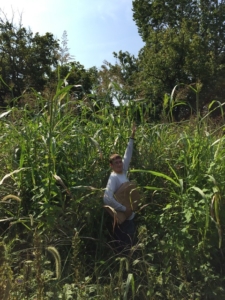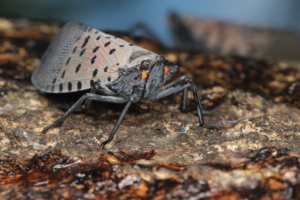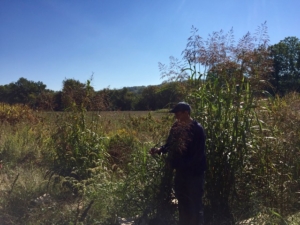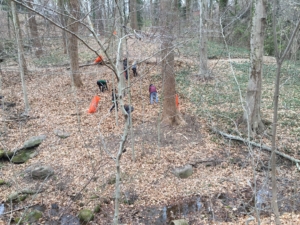Alien Invaders in the Chesapeake Bay
 From plants to insects to fish, it is estimated that there are more than 200 known or possible invasive species in the Chesapeake Bay watershed. These species, whether introduced accidentally or purposefully, can cause irreparable harm to native species in the region by competing for food or habitat. By outcompeting native species, invasive species not only disrupt the ecosystem of the Chesapeake Bay, but they can also cause economic harm.
From plants to insects to fish, it is estimated that there are more than 200 known or possible invasive species in the Chesapeake Bay watershed. These species, whether introduced accidentally or purposefully, can cause irreparable harm to native species in the region by competing for food or habitat. By outcompeting native species, invasive species not only disrupt the ecosystem of the Chesapeake Bay, but they can also cause economic harm.
The cost of invasive species
 The economic impacts of invasive species can range from decreasing agricultural yields to outcompeting commercially important species. A recent study conservatively estimated that invasive species have cost the North American economy at least $1.26 trillion USD between 1960 and 2017. The study stated, however, that very few of the known invasive species in North American had reported economic costs and more rigorous reports are needed to provide a comprehensive picture and support data-based management decisions and actions toward invasive species.
The economic impacts of invasive species can range from decreasing agricultural yields to outcompeting commercially important species. A recent study conservatively estimated that invasive species have cost the North American economy at least $1.26 trillion USD between 1960 and 2017. The study stated, however, that very few of the known invasive species in North American had reported economic costs and more rigorous reports are needed to provide a comprehensive picture and support data-based management decisions and actions toward invasive species.
Jacob Barney, an invasive plant ecologist at Virginia Tech, spoke about the history and his research on Johnsongrass, a forage plant originally introduced during the Civil War, that has since become a problematic agricultural weed causing serious economic losses. He explained that Johnsongrass is considered problematic for a number of reasons, “First, as a crop weed it can cause large yield reductions and thus losses in revenue. This is a problem globally and I think it’s a pressing ecological and economic issue that is projected to only worsen.” Johnsongrass can also displace native vegetation in disturbed sites, like roadsides, and semi-natural grasslands.
 Barney continued that the introduction of Roundup Ready glyphosate-resistant crops in the 1990s seemed to simplify weed management and reduce the pressure of weeds on agricultural crops at first. However, Johnsongrass quickly developed resistance to the herbicide, further adding to its difficulty to control and manage. Lastly, Johnsongrass is a perennial that reproduces both by seeds and through a large and extensive rhizome system underground that makes it particularly difficult to control, let alone eradicate.
Barney continued that the introduction of Roundup Ready glyphosate-resistant crops in the 1990s seemed to simplify weed management and reduce the pressure of weeds on agricultural crops at first. However, Johnsongrass quickly developed resistance to the herbicide, further adding to its difficulty to control and manage. Lastly, Johnsongrass is a perennial that reproduces both by seeds and through a large and extensive rhizome system underground that makes it particularly difficult to control, let alone eradicate.
At Penn State University, Kelli Hoover’s research focuses on invasive insect species, and she has been studying spotted lanternfly since 2018. The spotted lanternfly (SLF) is a sap-feeding invasive insect that poses a threat to commercially important agricultural crops and tree species, like hardwood, fruit trees, grapevines, and ornamentals. Feeding damage from the SLF significantly stresses the plants and can lead to decreased health and potentially death. In addition to plant damage, SLF excrete honeydew while they feed which builds up and promotes growth of black sooty mold, which can cover the plant, forest understories, and more.
 A study by Penn State researchers focusing on the economic impacts of spotted lanternfly found that the effects on agriculture and forestry industries in Pennsylvania could be considerable if the insect is uncontained. While there are quarantine measures and management practices in place, the impact of the spotted lanternfly is already significant and if SLF were spread throughout Pennsylvania, the expected losses could amount to $324.9 million annually with a loss of 2,810 jobs.
A study by Penn State researchers focusing on the economic impacts of spotted lanternfly found that the effects on agriculture and forestry industries in Pennsylvania could be considerable if the insect is uncontained. While there are quarantine measures and management practices in place, the impact of the spotted lanternfly is already significant and if SLF were spread throughout Pennsylvania, the expected losses could amount to $324.9 million annually with a loss of 2,810 jobs.
Climate change
Climate change can further compound the impacts of invasive species. Climate change impacts, like warmer temperature or increased precipitation, can stress out existing native plants and habitats and allow invasive species to further their competitive advantage over native species within the same growing space. Temperature changes can also expand the geographic range of certain invasive species beyond their current boundaries.
The large geographic spread of the invasive weed Johnsongrass ranges from Georgia to New York and west to California, which is unusual for a warm-weather plant that should be more climatically limited. Research into the genetics and evolutionary history of Johnsongrass have found that the weed can adapt rapidly to novel conditions, which facilitates its ability to spread quickly. Barney and his team are using Johnsongrass as a system to study, large-scale geographic expansion and local adaptation to try and answer the fundamental question about what exactly makes some introduced species become invasive.
 With climate change and warming weather, this introduces the question of whether Johnsongrass will become the “weed of the future” in colder climates where it can and does exist but is still relatively uncommon. Barney said, “the weeds of agricultural importance in New York, may look like that of South Carolina in 15 years. The weeds will be shifting northward and farmers and land managers across different ecosystems will be facing plants they’ve never really had experience with before.”
With climate change and warming weather, this introduces the question of whether Johnsongrass will become the “weed of the future” in colder climates where it can and does exist but is still relatively uncommon. Barney said, “the weeds of agricultural importance in New York, may look like that of South Carolina in 15 years. The weeds will be shifting northward and farmers and land managers across different ecosystems will be facing plants they’ve never really had experience with before.”
The spotted lanternfly has been found in multiple states so far, including Pennsylvania, New Jersey, New York, Ohio, Connecticut, Maryland, Delaware, Virginia, and West Virginia. The continuing spread of this pest to neighboring states could be potentially devastating for agriculture and forestry industries and a habitat-modeling study from the U.S. Department of Agriculture found that large areas of the United States and beyond are likely to be vulnerable should the spotted lanternfly continue to spread.
Managing invasive species
 Laura Greenleaf is a Virginia Master Naturalist that helps lead the Invasive Plant Task Force dedicated to the James River Park System. This task force was formed in 2015 to take a strategic approach to invasive species management in the park. To start this approach, the task force completed a data-driven baseline study on invasive plant species in the park system and then created a long-term plan for invasive management and restoration ecology in the park. She highlighted some overarching priorities, which include preserving tree canopy, identifying native flora communities that need to be protected, identifying emerging threats, and enhancing visitor experience in the park system.
Laura Greenleaf is a Virginia Master Naturalist that helps lead the Invasive Plant Task Force dedicated to the James River Park System. This task force was formed in 2015 to take a strategic approach to invasive species management in the park. To start this approach, the task force completed a data-driven baseline study on invasive plant species in the park system and then created a long-term plan for invasive management and restoration ecology in the park. She highlighted some overarching priorities, which include preserving tree canopy, identifying native flora communities that need to be protected, identifying emerging threats, and enhancing visitor experience in the park system.
Greenleaf detailed the completed project timeline so far, which includes a baseline survey that resulted in a park system-wide inventory of invasive species, their locations, and the extent of their cover, as well as anecdotal data on communities of native plants and areas of high priority for protection. To manage invasive species in the park system, they use a project-based approach to concentrate resources on specific project areas with attainable goals.
Another way to manage and limit the movement of known invasive species is to add them to noxious weed lists, which are regulatory lists of species that the federal government and 46 states maintain. Once a plant is listed as a noxious weed, it becomes regulated, and usually illegal to move into, or within the state. Barney explained, “the idea is that if we’re proactive and we list species that are not currently in Virginia, for example, then this policy gives the government some tools, and ideally resources, to help prevent that species from becoming common.”
To stop the spread of spotted lanternfly, the Pennsylvania Department of Agriculture has a quarantine in place for counties where SLF has been confirmed. This quarantine requires all businesses and organizations moving vehicles or items within or from the quarantine zone in the course of their work to obtain permits and to inspect all items for the invasive insects and their egg masses.
Managing species takes time, money, and patience and the economic impacts of invasive species, whether plant, animal, or insect, include direct effects on property values, agricultural productivity, public utility operations, native fisheries, tourism, and outdoor recreation, as well as costs associated with invasive species control efforts.
Works Cited
Crystal-Ornelas R, Hudgins EJ, Cuthbert RN, Haubrock PJ, Fantle-Lepczyk J, Angulo E, Kramer AM, Ballesteros-Mejia L, Leroy B, Leung B, López-López E, Diagne C, Courchamp F (2021) Economic costs of biological invasions within North America. In: Zenni RD, McDermott S, García-Berthou E, Essl F (2021) The economic costs of biological invasions around the world. NeoBiota 67: 485-510. https://doi.org/10.3897/neobiota.67.58038
Harper, J. K., W. Stone, T. W. Kelsey, and L. F. Kime. 2019. Potential economic impact of the spotted lanternfly on agriculture and forestry in Pennsylvania. The Center for Rural Pennsylvania, Harrisburg, PA. https://www.rural.palegislature.us/documents/reports/Spotted-Lanternfly-2019.pdf
Tewodros T Wakie, Lisa G Neven, Wee L Yee, Zhaozhi Lu, The Establishment Risk of Lycorma delicatula (Hemiptera: Fulgoridae) in the United States and Globally, Journal of Economic Entomology, Volume 113, Issue 1, February 2020, Pages 306–314, https://doi.org/10.1093/jee/toz259
